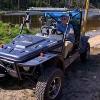Unique Fixes
-
Similar Topics
-
By downseast
Hi everyone
Recently purchased a 2020 T-Boss 410 in what appears to be good condition
First time with this machine – I also have a diesel Kawasaki Mule which so far seems a better machine
It didn’t start and idle well particularly from cold when I got it and sudden take off ( now solved with new clutch parts ) was all or nothing !
I have replaced the idle valve, throttle position sensor, had the injector professionally checked ( ok) and also the pressure sensor this is a fuel injection engine, also plug and lead etc!
It still doesn’t run well and when starting I have to hold revs for a while as it wont idle but stall, thereafter its better and I have rebooted the ecu which has improved it
When I go to start it clicks as if there is a hydraulic lock and wont return after two or three attempts it then does turn over and start bit I need to give it a bit of throttle to start – is this normal ?
Is there adjustment for the air idle valve ?
The engine seems rough and with vibration compared to other engines I have been used to but some say this is normal?
I haven’t changed the Lambda sensor yet, anyone know how much difference this might make ( I have a new Bosch universal to fit )
Any advice very much appreciated, thanks
-
By Jim Kessell
2005 American Landmaster
EH65 Subaru Robins
spits fuel from breather hose into the air cleaner and then down into carb. What’s causing this ??
-
By SayHiToRambo
08 trooper 1100
Bit of background. First the machine would take for ever to start. So I adjusted the valve shims into spec and made sure the timing is correct. Starts perfectly now.
now it fluctuates on idle. Bogs down, Revs up, repeat. I noticed the fuel pressure drops from 60psi to 20psi while that happens. It also bogs down at the lower end of each gear, higher rpm seems to be fine. Seems to struggle under load. In neutral it revs up perfectly.
brand new fuel pump, fuel filter, gas. I noticed on the fuel pressure regulator there’s that vacuum nipple, it’s not attached to anything and I’m not sure where it would go. Possibly the problem?
Another issue is the tip off the end of the exhaust is broken off, sensor is still attached and connected. Could that cause these issues?
my next plan was to look into the pressure regulator and voltage to fuel pump while driving. Is there anything I’m missing or any ideas you guys have?
thanks!
-
By boydog40
my subaru gave it up, bought a new Predator 670cc
problems is, wiring the buggy to the new motor, OEM key switch has 5 wires (red, green, yellow, black and brown)
new motor has many more wires than the Subaru and i have no idea what goes where!!!
finding any info on the web is almost impossible to do also
any help will be greatly appreciated!
thanks guys
-
-
By Jacob E freeman
I have a 2018 cub cadet challenger 750 I bought brand new almost 2 years ago the first month I had it the exhaust broke and burnt the spark plug wire in two that was a recall so the dealership installed the new one it had a different design and it bolted up to the bottom two plugs below the spark plug the dealership said they had to Adjust the exhaust valves I get the machine back thanking everything is good now wrong not even a week after I get it back the timing chain tensioner comes apart inside the motor I take it back to the dealership They put one on I get the machine back thanking everything is good but then just like before not even a week goes by when I was riding the Machine automatically quits going come to find out the wet clutch was burned up the primary clutch head stripped off of the splines I get that fixed and then it overheats I take it back they bleed the air out of the coolant they bring it back to me the same day that I get it back it overheats again I take it back they temporarily fix it again just enough to let the warranty run out and now the machine has been to multiple different mechanics I have had them try to bleed the air out they have stood it up on its end I have had the water pump changed I have had the fan hooked to a switch so I could leave it on all the time but still almost 2 years later not even 200 hours on the machine and I cannot ride it The dealership will not take it back as a lemon I have tried I am at my wits end I have no clue what to try next
-







Recommended Posts
Join the conversation
You can post now and register later. If you have an account, sign in now to post with your account.
Note: Your post will require moderator approval before it will be visible.